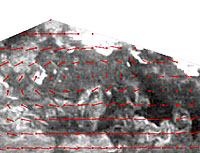Industrial Vision
Estimation of Turbulent Airflow in Livestock Buildings
 The goal for this project is to estimate flow fields for the turbulent
airflow that occur in livestock buildings for subsequent use in a further
modelling and quantitative determination of relevant parameters. The
end goal being to enable us to predict risk of draft as a function of
the ventilation system.
The project is a collaboration between the
Informatics and Mathematical Modelling at
The Technical University of Denmark, and
the Statens Jordbrugstekniske Forsøg, Bygholm. This project is funded
by Statens Jordbrugs- og Veterinærvidenskabelige Forskningsråd,
and the two collaborators.
All experiments are carried out at
Statens Jordbrugstekniske Forsøg in the Airphysics Laboratory.
A full-scale model as well as a 1:10 model of a segment of a livestock
buildings is used. The airflow is visualized by inducing smoke
in the air-inlets og the model and illuminating a plane using a laser
sheet.
The smoke in the illuminated plane is recoded using a light sensitive
video camera.
more
The goal for this project is to estimate flow fields for the turbulent
airflow that occur in livestock buildings for subsequent use in a further
modelling and quantitative determination of relevant parameters. The
end goal being to enable us to predict risk of draft as a function of
the ventilation system.
The project is a collaboration between the
Informatics and Mathematical Modelling at
The Technical University of Denmark, and
the Statens Jordbrugstekniske Forsøg, Bygholm. This project is funded
by Statens Jordbrugs- og Veterinærvidenskabelige Forskningsråd,
and the two collaborators.
All experiments are carried out at
Statens Jordbrugstekniske Forsøg in the Airphysics Laboratory.
A full-scale model as well as a 1:10 model of a segment of a livestock
buildings is used. The airflow is visualized by inducing smoke
in the air-inlets og the model and illuminating a plane using a laser
sheet.
The smoke in the illuminated plane is recoded using a light sensitive
video camera.
more
Contact:
Rasmus Larsen
Intelligent Sensor for Autonomous Cleaning
 Manual cleaning of livestock buildings, using high-pressure water
technology, is one of the most tedious and health threatening tasks
conducted by human labour. The cleaning process itself contributes to
deterioration of the working environment due to stirring up dirt,
micro organisms and water, which are inhaled by the
operator. Consequently, improving the working conditions for personnel
performing cleaning of today's livestock buildings is
essential. Societies concerns about food safety and livestock welfare
are also important issues on the modern farmer's agenda.
Ongoing research in Europe includes development of autonomous cleaning
robots, of which few are commercialised. Further investigations have
shown that robot performance is poor regarding effectiveness and
utilization of detergent and water. The water consumption for robotic
cleaning is up to 40% higher than what is used for manual
cleaning. Robotic cleaning often entails subsequent manual cleaning
because the robot did not detect the cleanliness of the surfaces.
The aim of the project is to improve the human working environment,
secure the hygienic standard and optimised use of cleaning resources
in livestock buildings. The specific objective is to develop an
intelligent sensor system that can supply data to a system for
autonomous cleaning of livestock compartments.
more
Manual cleaning of livestock buildings, using high-pressure water
technology, is one of the most tedious and health threatening tasks
conducted by human labour. The cleaning process itself contributes to
deterioration of the working environment due to stirring up dirt,
micro organisms and water, which are inhaled by the
operator. Consequently, improving the working conditions for personnel
performing cleaning of today's livestock buildings is
essential. Societies concerns about food safety and livestock welfare
are also important issues on the modern farmer's agenda.
Ongoing research in Europe includes development of autonomous cleaning
robots, of which few are commercialised. Further investigations have
shown that robot performance is poor regarding effectiveness and
utilization of detergent and water. The water consumption for robotic
cleaning is up to 40% higher than what is used for manual
cleaning. Robotic cleaning often entails subsequent manual cleaning
because the robot did not detect the cleanliness of the surfaces.
The aim of the project is to improve the human working environment,
secure the hygienic standard and optimised use of cleaning resources
in livestock buildings. The specific objective is to develop an
intelligent sensor system that can supply data to a system for
autonomous cleaning of livestock compartments.
more
Contact:
Ian Braithwaite,
Skjalm R. Arrĝe